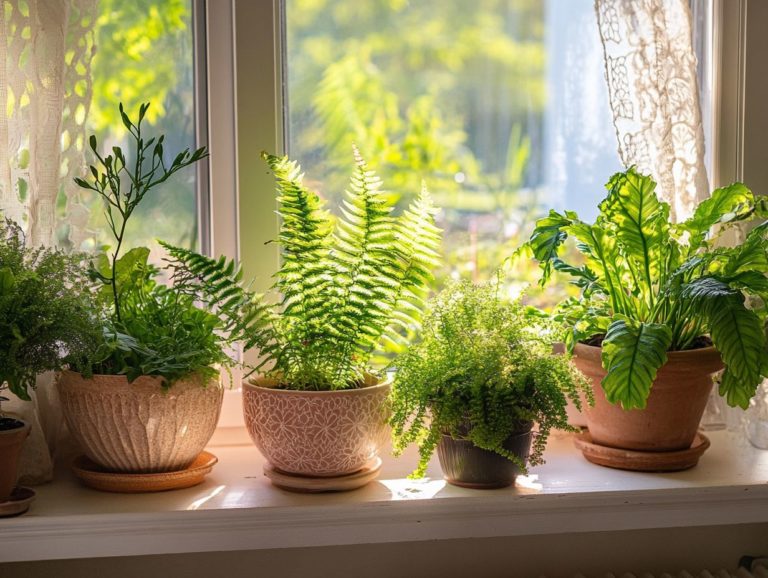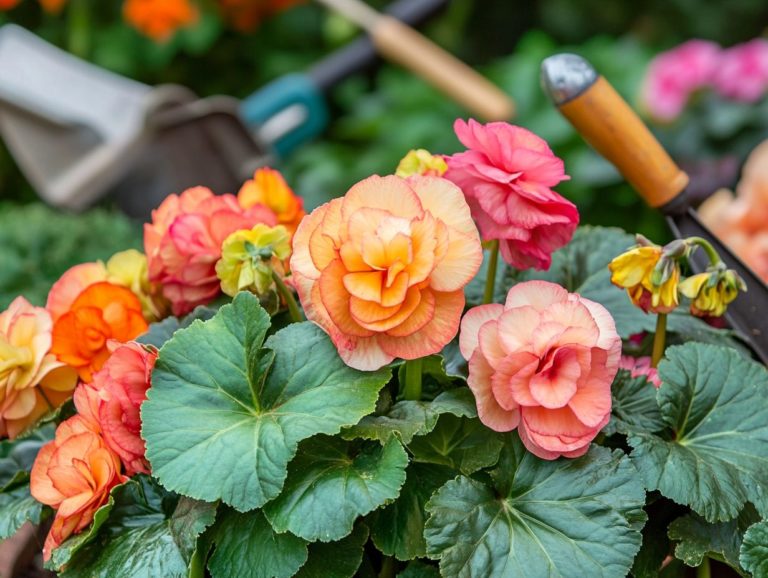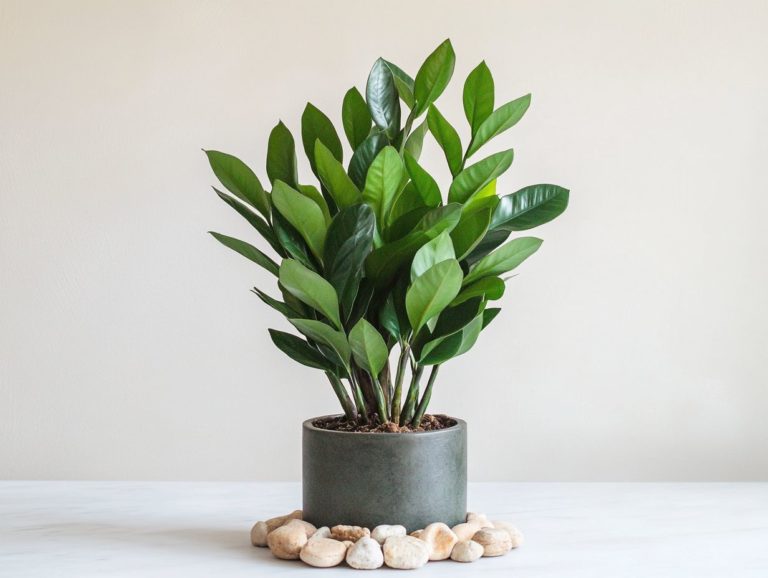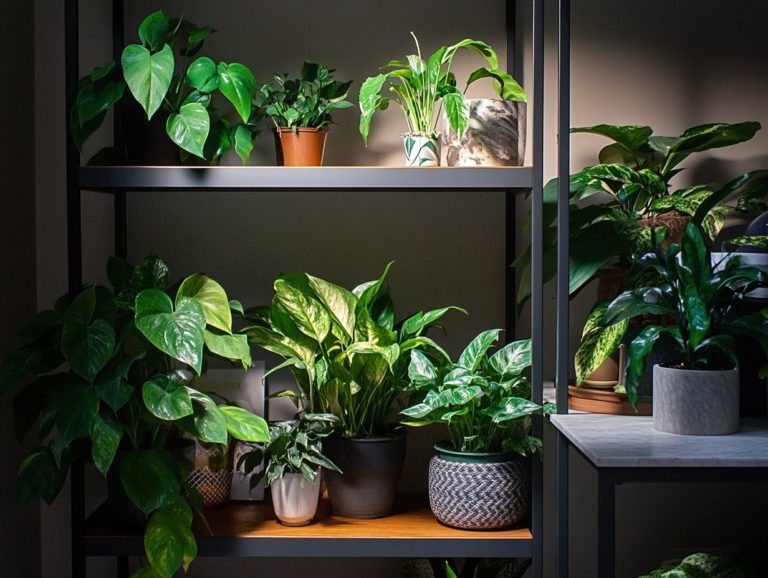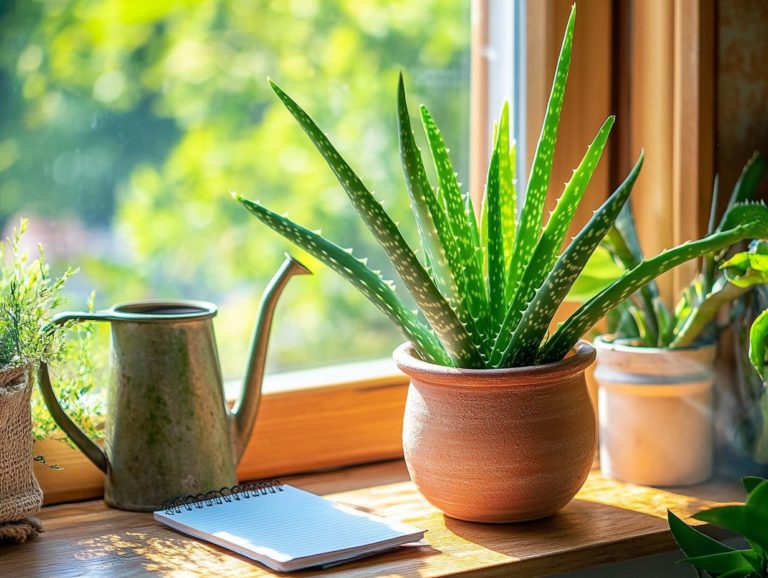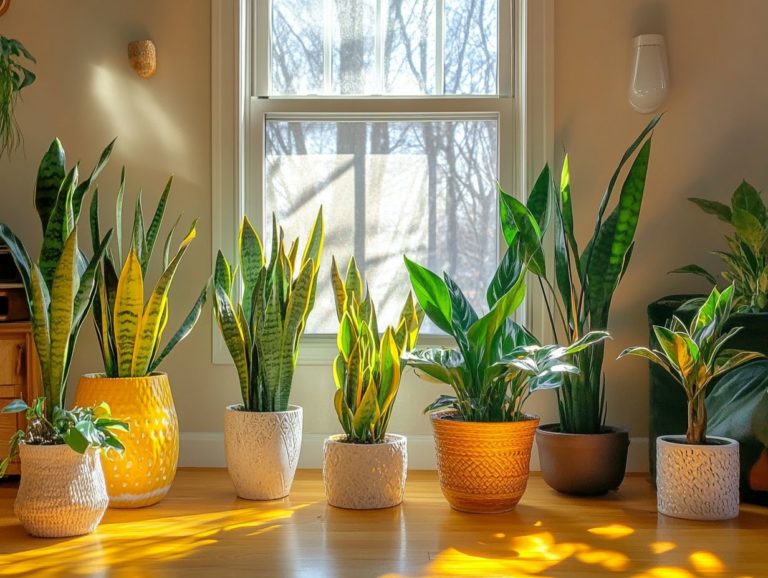Top 5 Indoor Plants for Allergy Sufferers
If you find yourself grappling with allergies, creating a calming home environment becomes paramount.
One unexpected ally in this endeavor? Indoor plants! They not only infuse your space with a refreshing touch of green, but specific varieties can also purify the air and ease allergy symptoms.
Discover five amazing indoor plants that will help you breathe easier and gather essential tips for their care. Don t wait! Transform your home into an allergy-friendly oasis today with these fantastic plants!
Contents
Key Takeaways:
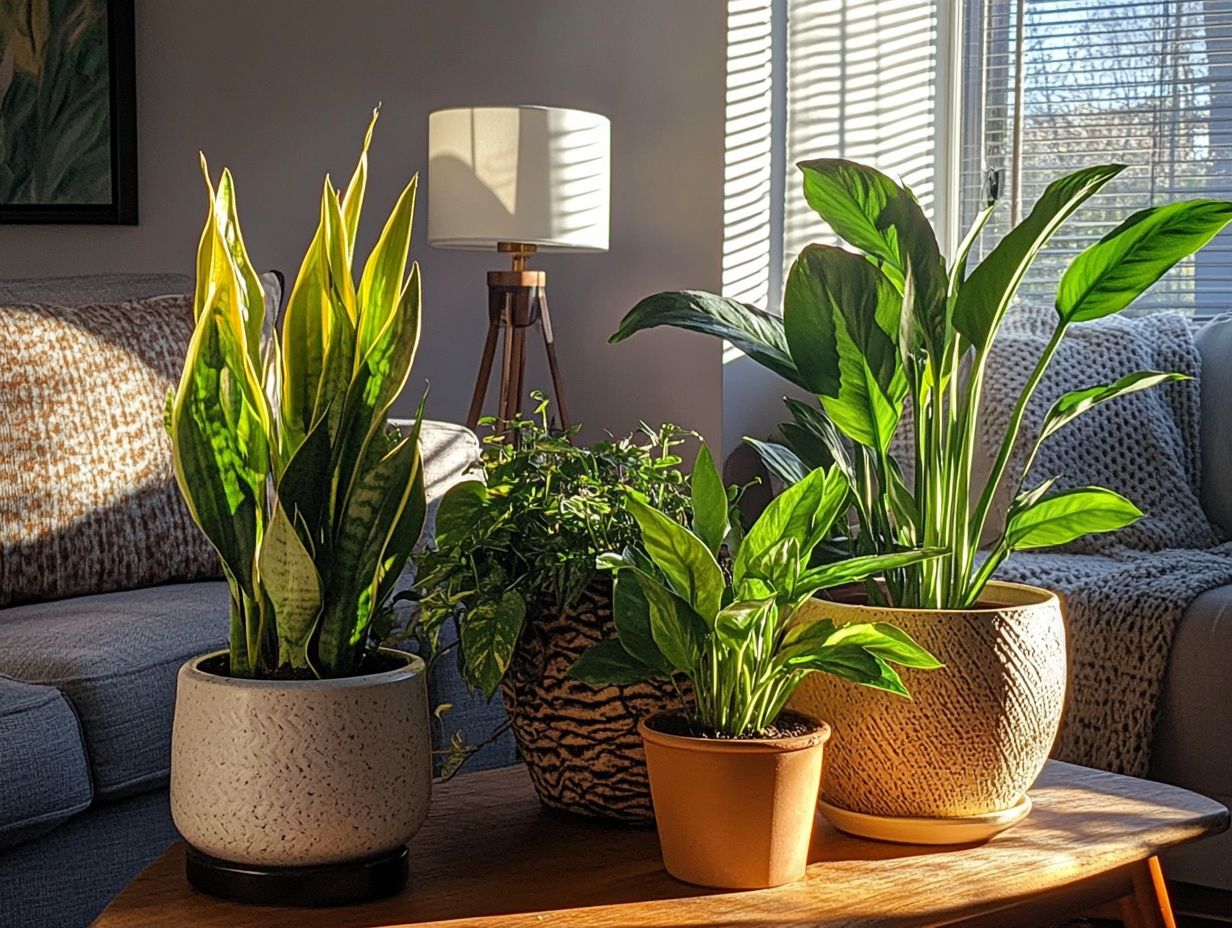
- Peace lilies, snake plants, aloe vera, spider plants, and dracaenas are the top 5 indoor plants that can help alleviate allergies.
- These plants purify the air by removing common allergens like mold, dust, and pollen.
- To ensure their effectiveness, it is important to properly care for these plants by providing adequate sunlight, water, and nutrients.
1. Peace Lily
The Peace Lily, with its stunning white flowers and glossy leaves, is a go-to choice for those looking to elevate their indoor spaces. Not only does it add a touch of elegance to your home, but it also works hard as an air purifier.
It effectively eliminates harmful indoor pollutants, which are harmful substances in the air, like formaldehyde, benzene, and xylene. This makes it an excellent option for anyone seeking allergy-friendly greenery, especially in low light conditions.
This resilient plant thrives in shaded areas and needs minimal sunlight to truly flourish. It s perfect for anyone wanting to keep their spaces vibrant without committing to extensive upkeep.
Watering is a breeze just give it a gentle soak when the top inch of soil feels dry, allowing you to enjoy the benefits without constant attention. The Peace Lily even has a built-in hydration indicator; it gently droops to let you know when it s thirsty.
With its impressive air purification abilities and low maintenance requirements, this charming plant is ideal for enhancing any indoor environment.
2. Snake Plant
The Snake Plant is an ideal addition to your indoor environment, celebrated for its effortless care and remarkable resilience. It thrives in low light conditions and significantly enhances your indoor air quality by absorbing toxins like carbon monoxide and formaldehyde.
This remarkable plant not only purifies the air but also regulates humidity levels, enhancing the overall comfort of your living spaces. By releasing moisture through its leaves, it creates a more pleasant atmosphere, especially in dry indoor climates.
Regarding care, the Snake Plant is a breeze requiring only a bit of indirect sunlight and occasional watering every few weeks to keep it in top shape. Its low maintenance demands make it the perfect choice for busy individuals.
3. Aloe Vera
Aloe Vera is not just a beautiful addition to your indoor space; it s also a powerhouse of healing properties and a natural air purifier. This exceptional plant excels at removing chemical residues and harmful organic compounds from the air.
It skillfully filters out pollutants like formaldehyde and benzene, creating a cleaner atmosphere in your home or office. Plus, taking care of it is a breeze. All it needs is a well-draining potting mix and bright, indirect sunlight.
Just remember to water it sparingly, allowing the soil to dry out completely between watering sessions to avoid the dreaded overwatering. By meeting these simple requirements, Aloe Vera can thrive, providing both visual charm and substantial air-purifying benefits.
It truly makes for an ideal companion in any indoor setting.
4. Spider Plant
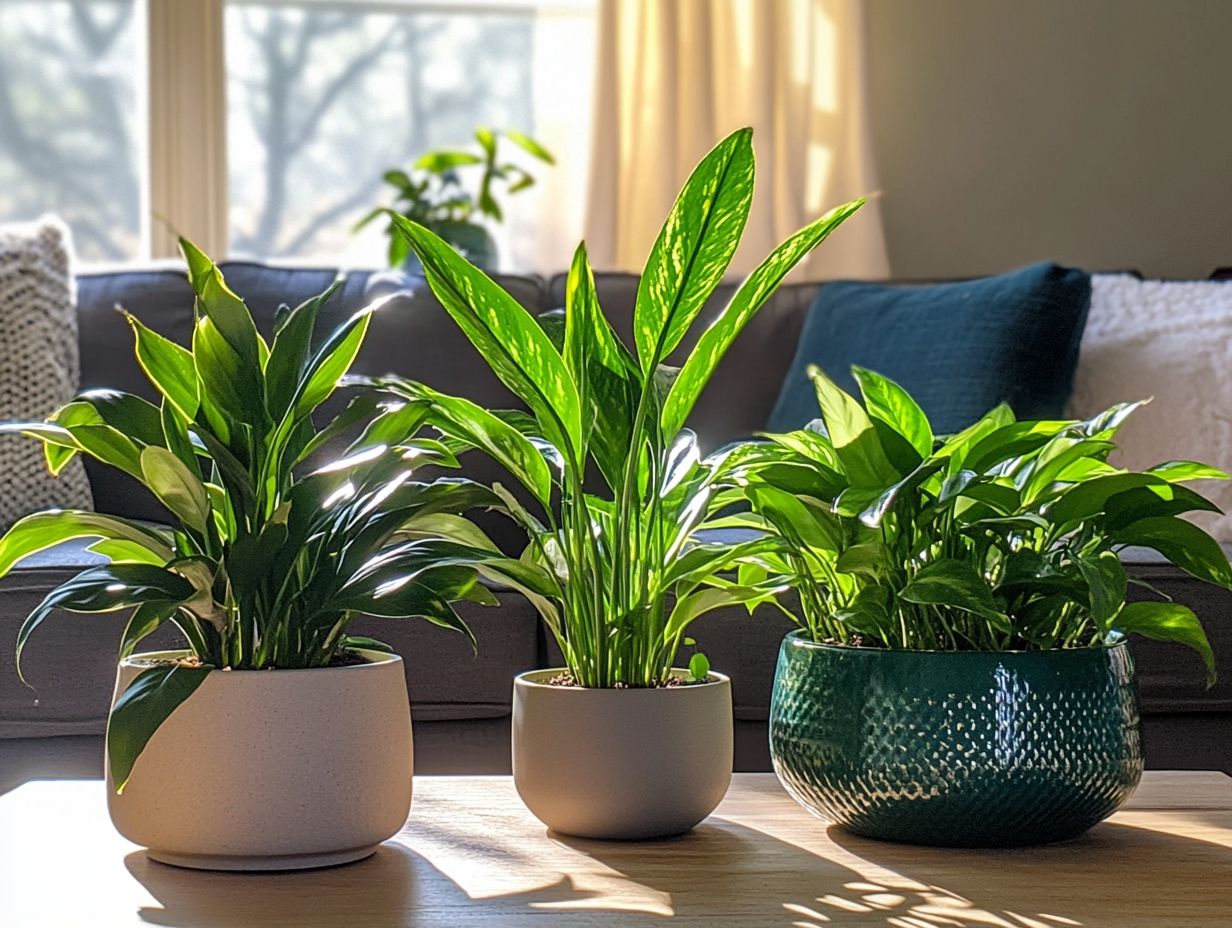
The Spider Plant is your go-to, allergy-friendly indoor companion, celebrated for its distinctive arching leaves and impressive ability to purify the air by eliminating common allergens like pet dander and dust mites. If you’re looking to create a healthy, clean air environment with minimal effort, this plant is an excellent choice.
Its talent for filtering toxins like formaldehyde and xylene boosts its reputation as an effective air purifier. It transforms any room into a breatheable oasis.
This resilient plant is perfect for those just starting out, requiring only moderate watering and indirect sunlight to thrive. It effortlessly adapts to various indoor conditions, whether you place it in a sunlit living area or a cozy, dim nook, making it a flexible addition to your home decor.
With its low-maintenance needs and impressive air-cleaning capabilities, incorporating the Spider Plant into your space can significantly elevate your indoor air quality while infusing a touch of greenery into your surroundings. For those interested in more options, check out the top 5 indoor plants for east-facing windows.
5. Dracaena
Dracaena, with its vibrant foliage and striking appearance, is an exceptional choice for your indoor garden. Not only does it beautify your space, but it also helps remove air pollutants like formaldehyde, greatly improving the air in your home. This makes it an essential addition to any allergy-friendly home.
This hardy plant thrives in many environments, showcasing a versatility that reflects its tropical origins. With just a bit of care such as allowing the soil to dry out slightly between waterings and providing indirect sunlight Dracaena adapts beautifully to low-light conditions.
By welcoming Dracaena into your home, you can enjoy a natural air filter that tirelessly works to cleanse your air of harmful substances while enhancing the beauty and ambiance of your living space. For those new to plant care, consider checking out the top 5 indoor plants for beginners. Its remarkable adaptability truly demonstrates how this stunning plant can seamlessly complement various interior designs.
Discover How Indoor Plants Can Ease Your Allergies!
Indoor plants are essential for alleviating allergy symptoms by enhancing air quality, eliminating common allergens and pollutants, and providing natural humidification. This means that plants add moisture to the air, helping to prevent dryness and regulating humidity levels in your home. Ultimately, this boosts the overall health benefits of your indoor living spaces, especially for allergy sufferers.
Research reveals that certain indoor plants, like spider plants and peace lilies, are particularly effective at filtering out airborne irritants such as dust mites and pollen. A notable NASA study underscores the remarkable ability of plants to purify indoor air, showing how they absorb toxins and convert them into cleaner air. For those looking to enhance bright spaces, consider the top 5 indoor plants. This natural filtration process not only reduces allergens but also helps maintain a balanced moisture level, contributing significantly to respiratory health.
Integrating these green allies into your living space can transform it into a more comfortable and healthier environment. Start adding these green allies to your space today for a healthier home!
What Are the Most Common Allergens Found in Indoor Air?
Indoor air often harbors a variety of allergens, such as dust mites, pet dander, and pollen, all of which can have a substantial impact on your indoor environment and may trigger allergy symptoms if you re sensitive.
Being aware of these allergens is crucial, as they can lead to discomfort like sneezing, runny noses, and even asthma attacks. Dust mites, for example, thrive in bedding, carpets, and upholstered furniture, making them a common nuisance in many homes.
Then there s pet dander tiny flakes from skin, fur, or feathers that can linger in the air and settle on surfaces, affecting those with sensitivities. Let s not forget about indoor mold spores, which often take up residence in damp areas and can contribute to respiratory issues and allergic reactions.
These allergens are everywhere in your living spaces, emphasizing the importance of keeping your environment clean and well-ventilated to minimize exposure and support your overall health. Incorporating shade-tolerant indoor plants can also help improve air quality while beautifying your home.
Discover How Indoor Plants Purify the Air
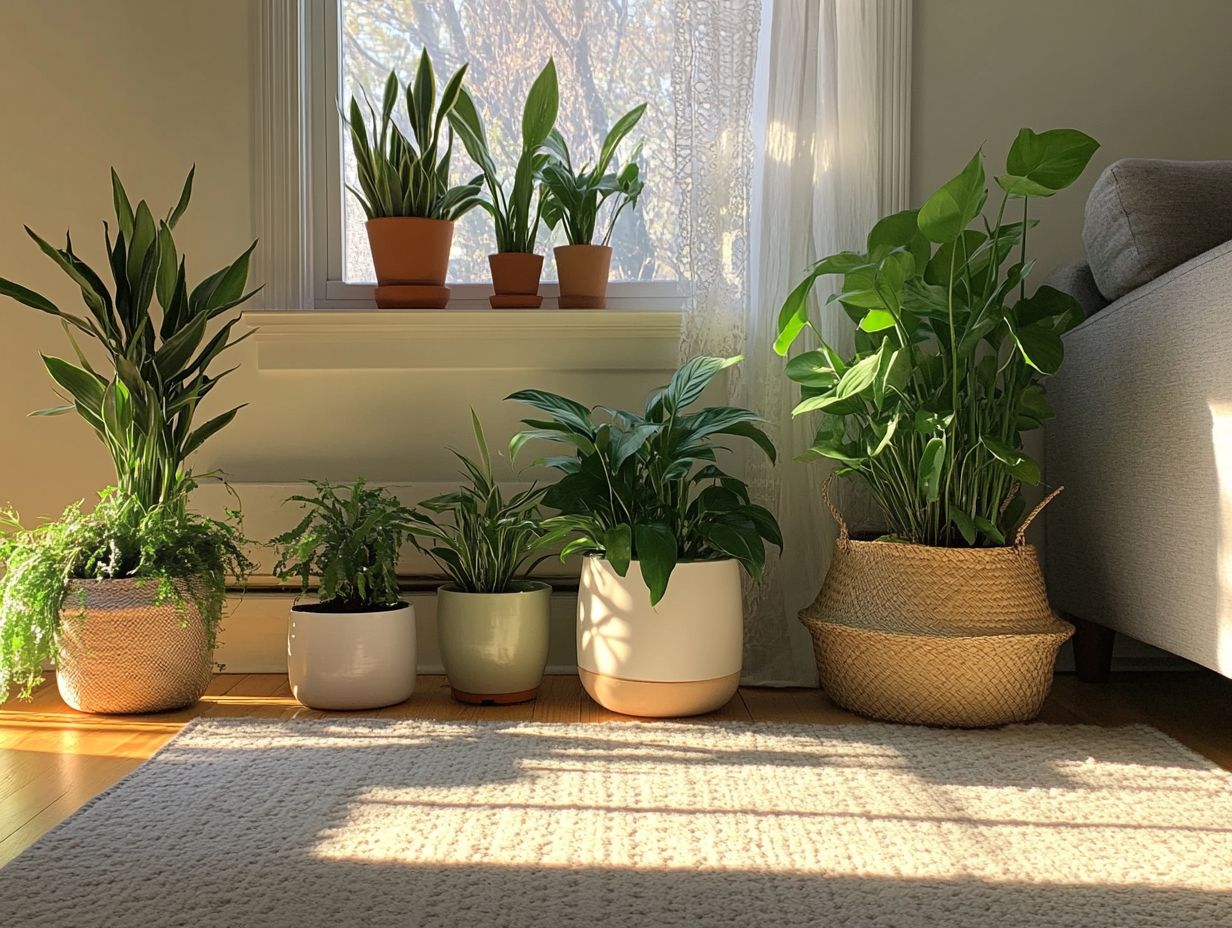
Indoor plants play a crucial role in purifying the air around you through several natural processes. They absorb chemical residues and organic compounds, effectively transforming harmful indoor air into cleaner, safer air for you to breathe.
These processes mainly involve photosynthesis and transpiration. During photosynthesis, plants take in carbon dioxide and release oxygen, significantly enhancing the air quality in your space. For instance, the Spider Plant and Peace Lily are celebrated for their remarkable ability to filter out toxins like formaldehyde and benzene. If you’re looking for plants that thrive in moist environments, check out the top 5 indoor plants for humid spaces.
Not only do these plants remove harmful substances, but they also increase indoor humidity by releasing water vapor into the air, alleviating dryness and improving your overall comfort.
Bringing these plants into your home adds a touch of beauty to your surroundings while contributing to a healthier living environment.
Best Ways to Care for Indoor Plants
Proper plant care is essential for maintaining the health and longevity of your indoor plants. This means regular watering and creating optimal light conditions. Monitoring humidity levels is also important, as each aspect contributes to the easy care and low maintenance of these green companions.
By understanding the unique needs of your indoor plants, you can create an environment that closely resembles their natural habitat. For instance, succulents thrive in bright, indirect light, while ferns prefer shadier spots with higher humidity.
Regularly assessing moisture levels is crucial. You want to ensure the soil isn t too dry or overly saturated. This vigilance helps prevent root rot and a host of other issues.
Consider incorporating humidity trays or misting for your tropical plants. These simple practices can significantly enhance their health.
Ultimately, recognizing these specific requirements ensures that each of your plants can flourish, providing not just beauty but also improving air quality in your living space.
Other Benefits of Having Indoor Plants
Beyond air purification, indoor plants offer an array of benefits that elevate your health and well-being. They improve air quality while creating a serene green oasis that adds a beautiful look to any space.
Indoor plants can lower your stress levels, as being surrounded by greenery promotes relaxation and tranquility. For those looking to enhance their space, consider the top 5 tropical plants for indoor environments; having plants around lifts your mood, transforming your environment into a more inviting and positive haven.
Indoor plants can also enhance your concentration and productivity, turning an ordinary room into an inspiring workspace. When thoughtfully integrated into your decor, they complement your furniture and design elements while making a stylish statement that reflects your personal taste.
Indoor Plants that Help with Allergies
In addition to popular choices like the Peace Lily and Spider Plant, consider other indoor plants such as the Rubber Tree and Weeping Fig, which are effective at purifying the air and reducing allergy triggers in your home.
- The Rubber Tree, with its large, glossy leaves, thrives in moderate light and requires minimal watering making it an ideal, low-maintenance option for those with busy lifestyles who still desire cleaner air.
- Similarly, the Weeping Fig filters out toxins and enhances your indoor environment, requiring consistent watering and indirect sunlight to thrive.
- Another excellent choice is the Boston Fern, which flourishes in humid conditions and naturally humidifies the air, though it requires regular misting to keep its lush foliage vibrant.
- Don’t overlook the Bamboo Palm, which adds a tropical flair while acting as a natural humidifier; it flourishes in low light with just occasional watering.
Bring home these plants to create a healthier, allergy-friendly atmosphere in your home.
Frequently Asked Questions
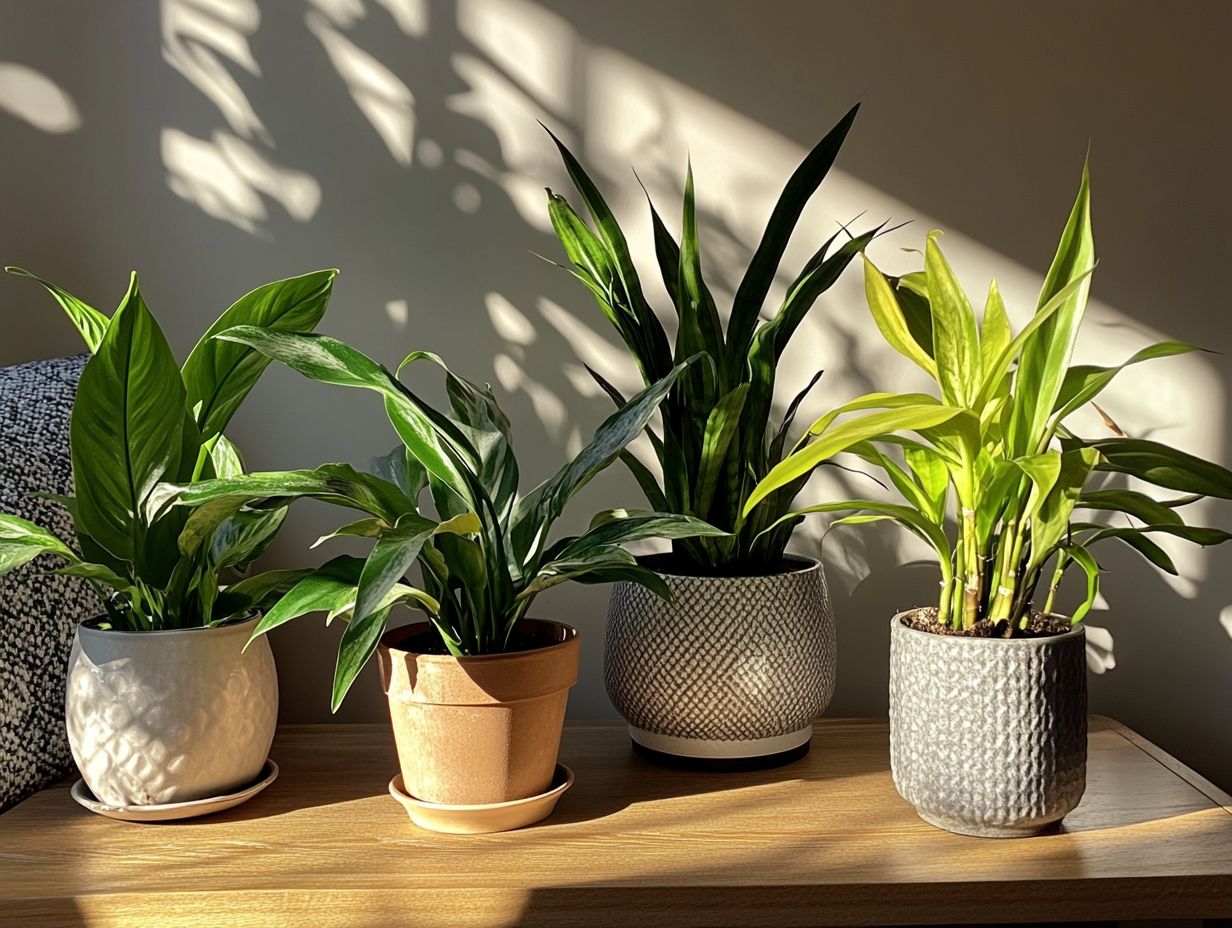
What are the top 5 indoor plants for allergy sufferers?
Discover the top 5 indoor plants perfect for allergy sufferers: snake plant, aloe vera, peace lily, spider plant, and philodendron. These amazing plants can help improve air quality and reduce allergens!
How do these plants help with allergies?
Indoor plants clean the air by absorbing toxins and releasing fresh oxygen. The top 5 plants target specific allergens like dust, mold, and pet dander.
Can these plants be harmful to allergy sufferers?
These plants are safe for allergy sufferers because they are low-maintenance and don t produce much pollen. Always research a specific plant before adding it to your home, especially if you have severe allergies.
Where should these plants be placed for maximum effectiveness?
Place these plants in your bedroom, living room, or any frequently used space. This promotes constant air circulation and purification.
Do these plants require a lot of sunlight?
No, these plants thrive in low-light conditions. Snake plant and philodendron can even survive with minimal light!
Are these plants easy to care for?
Absolutely! These plants need minimal watering and indirect sunlight. Just wipe their leaves occasionally to keep them dust-free.

